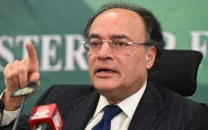An India-Pakistan pipeline a pipe dream
Delhi not considered trustworthy for LNG import as it could block supplies

Now, the Narendra Modi-led government, which came to power in May this year, is fuelling further trouble by resorting to unprovoked firing and shelling along the Line of Control in Kashmir.
Civilian governments have always been in favour of opening up trade with the neighbour, but Delhi is not a trustworthy partner and triggers clashes on the border from time to time, hampering a free flow of goods.

This is reflected in trade between Pakistan’s Azad Jammu and Kashmir and Indian-held Kashmir. The two-way movement of goods always gets disrupted whenever any incident occurs on the border.
Considering such fears, Pakistan could not entirely count on India to meet its energy needs. It had planned to import only 15% of oil consumption, but later scrapped that plan too.
According to officials, any LNG deal between the two countries would be only a political gesture to bring them closer. There are a few major hurdles in the way of a purely business agreement.
First, India demands higher prices that are not acceptable. Second, India is not an LNG producer itself, therefore, Pakistan is not over-ambitious about the deal. Third, as already stated, India is not a reliable trade partner. Fourth, Pakistani armed forces would not like the government to bank on India for vital fuel supplies. Like Pakistan, India is also experiencing gas shortage of 2 billion cubic feet per day and it will not be able to export LNG before meeting its consumption needs first.
Though officials of the two countries have held several rounds of negotiations on LNG trade, they have not produced any concrete outcome due to disagreement over the gas price. Delhi is not willing to budge from its stance and quotes a higher price of $21 per million British thermal units (mmbtu) compared to average price of around $16 in the region.
Qatar, a major LNG supplier, seeks a price of $17.4 while private suppliers demand $17.7 to $18.1 for the Sui Southern Gas Company (SSGC) project. The price demanded by India is even higher than the import cost of expensive furnace oil, which is used in power plants.
Earlier, in January 2011, a Dutch firm had offered to bring LNG at $11, but the project could not be pushed ahead and it landed in the Supreme Court, forcing the then Pakistan Peoples Party-led coalition government to abandon the plan.
Tax concession
Indian authorities have suggested that though they have different types of taxes on LNG, these could be waived by their government to pave the way for a trade deal.
This came in response to a request by a Pakistani delegation that visited Delhi in March this year, calling for exempting LNG export from taxes. This could bring the price down to $16 per mmbtu. But, officials say, the tax concession would also be based on political grounds and could be withdrawn any time.
Pakistani and Indian prime ministers could take some initiatives to push through an agreement. However, the hardline adopted by the Modi government so far could firmly stand in their way.
Under a proposed plan, India had offered to supply 200 million cubic feet of LNG per day (mmcfd) initially through the Wagah border by laying a pipeline to meet the energy needs of Punjab.
The pipeline would run 60 km from Bhatinda to Wagah border whereas Pakistan was also required to construct a 30km pipeline to inject gas into the system of Sui Northern Gas Pipelines Limited (SNGPL) to supply gas to Punjab.
Still a viable option
However, some officials are of the view that LNG import from India is the most viable option when many countries are scrambling to secure much-needed energy supplies. There would be no capital cost and imports could be started within months of agreement.
However, if LNG is brought through Karachi, the cost of laying a pipeline to Lahore will be $1.4 billion.
With work on building an LNG terminal at the Port Qasim in full swing, experts believe imports from India may not materialise. The government has also floated a tender for constructing another terminal with a capacity to handle 400 to 500 mmcfd.
Apart from that, Pakistan State Oil has also got offers of LNG export from major producing companies like British Petroleum.
The writer is a staff correspondent
Published in The Express Tribune, October 27th, 2014.
Like Business on Facebook, follow @TribuneBiz on Twitter to stay informed and join in the conversation.



















COMMENTS
Comments are moderated and generally will be posted if they are on-topic and not abusive.
For more information, please see our Comments FAQ